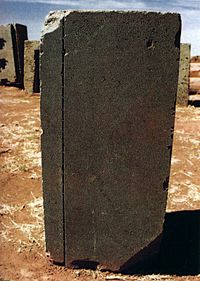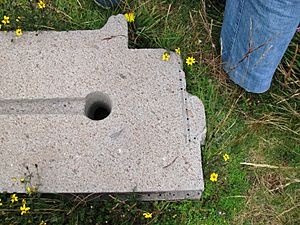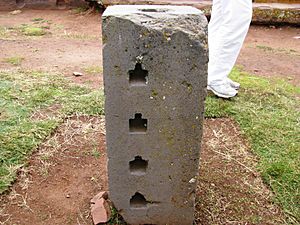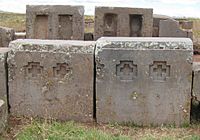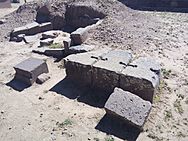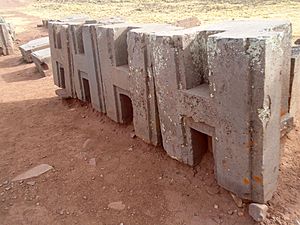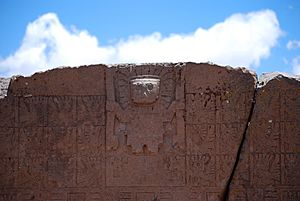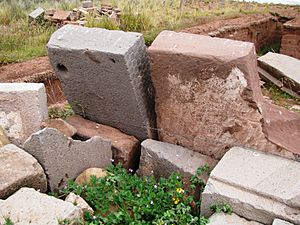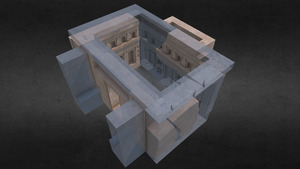Pumapunku facts for kids

View at the ruins of Pumapunku
|
|
| Alternative name | Puma Punku |
|---|---|
| Altitude | 3,850 m (12,631 ft) |
| Type | an alignment of plazas and ramps centered on a man-made terraced platform mound with a sunken court and monumental complex on top |
| Part of | Tiwanaku Site |
| Length | 116.7 metres |
| Width | 167.4 metres |
| Area | at least 14 hectares |
| History | |
| Material | sifted and layered soils (mound), andesite (superstructure), sandstone (foundation and internal channels), ternary Cu–As–Ni bronze alloy (cramps), mortar of lime and sand with ground-up malachite (turquoise green plaster floor), clay (red floor) |
| Founded | 536–600 |
| Cultures | Tiwanaku empire |
| Site notes | |
| Discovered | 1549 by Pedro Cieza de León (first European visitor) |
| Excavation dates | Vranich |
| Condition | Ruined |
| Architecture | |
| Architectural styles | Pumapunku Style architecture |
Pumapunku (also spelled Puma Punku) is an amazing ancient site in western Bolivia. Its name comes from the Aymara and Quechua words meaning 'Gate of the Puma'. It was built around 536–600 AD by the Tiwanaku empire.
Pumapunku is a large, T-shaped platform mound with terraces. It has a sunken courtyard and a grand structure on top. Today, much of this impressive complex is in ruins. It was the second most important building in the ancient city of Tiwanaku, after a similar structure called Akapana.
The Tiwanaku people believed this area was where the world was created. At its best, Pumapunku was likely a stunning place. It might have been decorated with shiny metal plaques and colorful fabrics. Important people and priests would have visited, wearing fancy clothes and jewelry.
Over time, much of Pumapunku has been damaged. This happened because people searched for treasure, stole stones, and natural weather wore it down.
Contents
- History of Pumapunku
- What Pumapunku Looks Like
- How Old is Pumapunku?
- Amazing Engineering
- How Pumapunku Was Built
- The Use of Cramps
- Connection to Ollantaytambo
- Gateways of Pumapunku
- Sculptures and the Gate of the Sun
- Roofs of Pumapunku
- Cultural Importance
- Rise and Fall of Tiwanaku
- Pumapunku and Pseudoscience
- Images for kids
- See also
History of Pumapunku
When the Spanish explorers first arrived in Tiwanaku in the 1500s, some parts of Pumapunku were still standing. A writer named Bernabé Cobo reported seeing one gateway and a "window" on one of the platforms.
What Pumapunku Looks Like
Pumapunku is a terraced mound made of earth, covered with stone blocks. It is about 167.4 meters (549 feet) wide from north to south. It is also about 116.7 meters (383 feet) long from east to west.
On the eastern side, there's a special stone terrace called the Plataforma Lítica. This terrace has some huge stone blocks. One of these is the largest stone slab at the entire Tiwanaku Site. It is about 7.8 meters (25.6 feet) long and 5.2 meters (17 feet) wide. This single stone is estimated to weigh around 131 tonnes (about 144 short tons)! People have been amazed by the size and smooth surfaces of these stones for hundreds of years.
The main structure of Pumapunku is made of clay. The outer parts are covered with a mix of andesite and red sandstone. Scientists have found that Pumapunku was built in at least three main stages, with repairs and changes made over time.
In 2016, drones were used to map the area. The results showed that the site covers about 17 hectares (42 acres). Only a small part of it has been uncovered so far. There are two more platforms still buried underground.
How Old is Pumapunku?
Scientists used a method called radiocarbon dating to find out how old Pumapunku is. They tested organic material from the deepest layer of the mound. This layer was put down during the first stage of building.
The tests show that Pumapunku was first built between 536 and 600 AD. Since the stone parts were added after this first layer, the stonework was likely built sometime after 536–600 AD.
Amazing Engineering
The largest stone block at Pumapunku weighs about 131 tonnes (144 short tons). It's made of red sandstone. Scientists believe these huge sandstone blocks were moved from a quarry near Lake Titicaca, about 10 kilometers (6 miles) away. Smaller andesite blocks came from even farther away, about 90 kilometers (56 miles) across Lake Titicaca.
It's still a mystery exactly how the Tiwanaku people moved these giant stones. They didn't have wheels or large animals to help. Some ideas suggest they used ropes made of llama skin or built ramps and slopes.
The stones at Pumapunku fit together like a perfect puzzle. Each stone was cut so precisely that it interlocked with the ones around it. This made the walls very strong. Some joints are so tight that you can't even fit a razor blade between the stones!
The cuts are so accurate that it looks like the stones might have been made in advance, almost like mass production. This was a very advanced technology for their time. Some unfinished stones show us how they might have shaped them.
Experts say that the Tiwanaku people must have used tools that we don't know about today. Their cuts are so clean and sharp, especially the 90-degree angles, that they couldn't have been made with simple hammerstones.
The Tiwanaku engineers were also very skilled at building. They created working irrigation systems, water channels, and waterproof sewage lines.
How Pumapunku Was Built
Pumapunku was a large mound made of earth with three levels of stone walls holding it up. It's shaped like a "T" rather than a simple square. To support the weight of these massive structures, the builders made very strong foundations. They often placed stones directly onto solid rock. Or, they dug trenches and filled them carefully with layers of different stones to support the huge blocks.
Modern engineers think the base of Pumapunku was built using a special layering technique. They alternated layers of sand and other materials. This created a very strong and stable base for the heavy stones.
The Use of Cramps
A unique feature at Pumapunku is the use of I-shaped metal clamps, called cramps. These cramps were made from a special bronze alloy containing copper, arsenic, and nickel. They were used to hold stone blocks together.
These I-shaped cramps were also found in a canal near another Tiwanaku structure called Akapana. They helped keep the walls and bottom of stone-lined canals in place. At Pumapunku, some of these cramps were poured directly into place when the metal was hot. This is different from the Akapana cramps, which were shaped by hammering cold metal.
Similar T-shaped sockets for cramps can also be found in ancient buildings in Peru, like Qorikancha and Ollantaytambo. This technique was also used in Ancient Egypt and Ancient Greece. Some experts believe that similar ways of thinking led different cultures to invent similar building methods.
Connection to Ollantaytambo
Some historians have wondered if the huge stone structures at Ollantaytambo in Peru were built by the Tiwanaku culture, even before the Incas. They point to features like the step design on one stone and the T-shaped holes cut into several blocks. These are similar to designs found in Tiwanaku architecture, especially at Pumapunku.
One idea is that skilled stonemasons from the Lake Titicaca area (where Tiwanaku is) brought their building knowledge to Ollantaytambo. However, at Ollantaytambo, only T-shaped holes are found. At Tiwanaku, many different shapes of cramp sockets exist, like L, T, U, Y, and Z. Still, the similarities are quite interesting!
Gateways of Pumapunku
Full-sized Gateways
It's believed that at least five large gateways were once part of the Pumapunku complex. The main platform of Pumapunku might have supported as many as eight gateways made of andesite stone. Fragments of five of these gateways have been found. They look similar to the famous Gate of the Sun at Tiwanaku.
Miniature Gateways
Pumapunku also has amazing miniature gateways. These are perfect, smaller copies of the full-sized monumental gateways that once stood there. The Tiwanaku people used a special formula to shrink the large buildings into these tiny models.
One famous example is the "Escritorio del Inca" (Inca's Desk) monolith. It's a very accurate, smaller model of a full-sized building. Many of these "model stones" were made in multiple copies, suggesting they were mass-produced.
Sculptures and the Gate of the Sun
There are at least two large stone sculptures, called monoliths, linked to Pumapunku. One is simply called the Pumapunku monolith.
There's also evidence that sculptures known as Chachapumas once guarded the entrance to Pumapunku. These sculptures often show fierce animals, crouching or kneeling. They hold a human head in one hand and an axe in the other. Some believe these sculptures suggested that a "sacrifice" was needed to enter the grand structures.
Many experts think the famous Gate of the Sun was once part of Pumapunku. The terraced platform shown on the Gate of the Sun might even be a stylized picture of Pumapunku itself. The patterns on the back of the Gate of the Sun are also found on stones at Pumapunku. This suggests they were connected.
Roofs of Pumapunku
The roofs of the entrance to Pumapunku were probably made of special "Totora-reed stones." These are stones carved to look like the Totora reeds that grow in the area. Early visitors to Tiwanaku reported seeing stones that looked like "straw" roofs. They said the stone was carved to make it appear like a straw covering, just like the local houses.
Large Totora-reed stones can still be seen in the museum at Tiwanaku today.
Cultural Importance
Some theories suggest that Pumapunku and other large structures at Tiwanaku were important spiritual and religious centers for the Tiwanaku people. This area might have been seen as the very center of the Andean world. People would travel from far away to see its beauty.
These structures changed the landscape around them. Pumapunku was even connected to the nearby Illimani mountain. The spiritual importance and wonder of the site might have created a powerful, life-changing experience for visitors.
Rise and Fall of Tiwanaku
The Tiwanaku civilization, and the use of these amazing buildings, seemed to be at its strongest from about 700 to 1000 AD. At its peak, the city of Tiwanaku and the surrounding area might have had 400,000 people!
They built a huge system of irrigation to water their crops. This system covered more than 30 square miles (78 square kilometers). It helped them grow potatoes, quinoa, corn, and other foods to feed their large population. During their best centuries, the Tiwanaku culture controlled a large area around Lake Titicaca and parts of Bolivia and Chile.
However, this powerful culture suddenly disappeared around 1000 AD. Researchers are not entirely sure why. A likely reason is a long and severe drought. Without enough water, they couldn't grow enough food for everyone. The Tiwanaku people likely scattered into the nearby mountains and then vanished. It seems Pumapunku was abandoned before it was even completely finished.
Pumapunku and Pseudoscience
Pumapunku is sometimes talked about in theories that are not based on science. These theories suggest things like lost continents or even visitors from outer space helped build it. Thousands of websites and TV shows mention these ideas.
Some people who believe in "ancient aliens" point to the perfectly cut stones and Pumapunku's high location in the Andes mountains as mysteries. They claim that humans at that time couldn't have built it.
However, archaeologists like Alexei Vranich explain that there are older, well-preserved buildings in the area (like at Pukara and Chiripa) that show how the Tiwanaku people's building skills developed over time. These older buildings are similar to Pumapunku's design. This shows that the Tiwanaku people themselves were skilled builders, and no outside help was needed.
Archaeologists also point out that some ancient alien theorists have unfairly called the Aymara people "stone age people" who couldn't have built Pumapunku. This ignores the amazing skills and knowledge of the people who lived in the Titicaca basin.
Images for kids
-
A comparison of the Tiwanaku cramp technique (left) with a similar one in Delphi (right)
-
"Nested square" symbol inside one "H-block." Similar symbols are found on stone stelas in the museum at Pukara.
See also
 In Spanish: Puma Punku para niños
In Spanish: Puma Punku para niños



